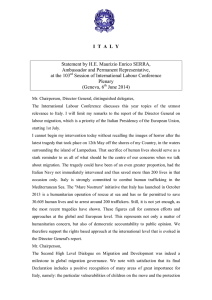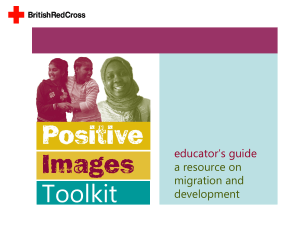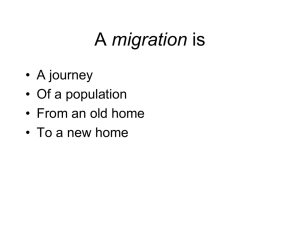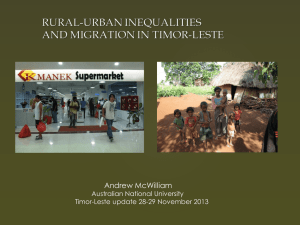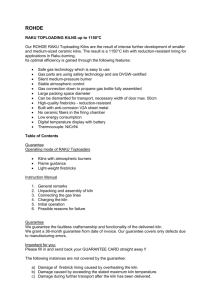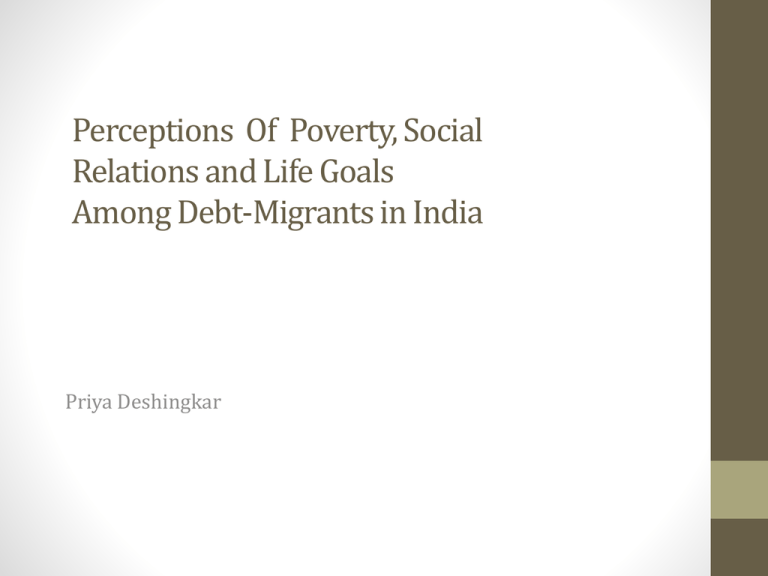
Perceptions Of Poverty, Social
Relations and Life Goals
Among Debt-Migrants in India
Priya Deshingkar
Introducing debt-migration
• Migration is an expensive undertaking, historically accessible
only to the better off
• Now networks of agents offering loans and covering costs of
migration in sectors ranging from construction, domestic work,
industrial work and sex work.
• Debt-migration – migrant remains indebted for long periods of
time, foregoing wages and other freedoms to repay the debt.
• ILO research on modern forms of slavery stresses that nearly all
forced labour is for economic exploitation and labour market
intermediaries such as recruitment agents are the main
channel through which such exploitation occurs.
• Migrants own accounts of their experience and long term
aspirations at odds with this narrative
Overview
• Discourse on migration and debt-migration in
particular
• Study sites and methods
• Migrants’ perceptions of poverty, social
relations, changing identities and life goals
• Implications for policy and issues for further
research
Discourses on debt-migration
• Research on unfree labour relations in India
• Interlocking of credit, labour and output markets; semifeudal societies (Bhaduri, Bharadwaj)
• Persistence of unfree labour in modern forms of
production (Brass)
• Migration as an extension of class/caste/patriarchy
based systems of exploitation (Breman 1983, Olsen and
Ramanamurthy 2000)
• Neoclassical economic theory explains such
arrangements as risk-averse behaviour by the poor
• Present analysis somewhere in between – recognising
the role of structure but also the transformative role of
agency in explaining the persistence of such migration
Policy positions
on debt migration
• Policies are informed by theories of unfree labour and dependency
and have sought to control migration. E.g. one of the objectives of
the MGNREGA and watershed programmes is to reduce migration.
• I have long argued against this by highlighting the developmental
potential of migration and called for policies that reduce the costs
and risks of migration.
• Evidence of a shift at higher levels of policy e.g. Approach paper to
12th plan and Steering Committee on Urbanisation
• But there is no indication of a change in positions on debt-migration
which is still seen as a form of modern day slavery
• Efforts are still focused on releasing workers from bondage and
ending the system of market intermediaries
• Evident in the language of labour and migration laws as well as
mission statements of national and international NGOs
• Construction work and Brick kiln work often targeted
Study sites and methods
• This research draws on studies that I undertook in the states of
Bihar (mainly rural interviews) , Andhra Pradesh (both urban and
rural) and Maharashtra (urban) at different points in time and
under different projects. All of these projects were on migration
and poverty
• Felt that comparing the same type of migration in different
contexts, involving different groups of people would yield
interesting findings.
• Sites were chosen purposively to maximise chances of covering
migrants; interviews with those who were willing to participate
• Being a Marathi speaker brought up in Delhi and having lived for
12 years in Hyderabad gave me an advantage in understanding
the meanings as expressed by migrants.
The context
Labour market characteristics
• Expected to find differences in working conditions but
strikingly similar, in terms of overall situation, despite
differences in context
• Seemed to be a more or less standard models for recruiting
construction workers and brick kiln workers
• While wages for construction workers were somewhat higher
in the more developed cities, wages for brick kiln workers
were almost the same.
• Instead of improving conditions of employment due to the
presence of civil society organisations, employers are sourcing
workers from poorer and more isolated communities with few
links to NGOs and unions
• There were small and less visible but important differences in
the conditions between workers in both categories
Composition of the workforce
• Evidence of larger diversity of construction workers in Pune
in terms of place of origin
• But mainly dalits and poorer backward castes and muslims
– agents do not prefer to recruit adivasis for this kind of
work as they are not seen to be capable of doing it.
• Brick kiln workers tend to be sourced more locally and
Adivasis are heavily represented
• In general more men-only migration in Bihar than
Maharashtra and AP – North Indian culture as well as
restriction on women’s work in Muslim families (as we will
see this is changing)
Debt migration for construction
work, a litany of broken laws
• Groups of workers recruited by agent
mestri/thekedar/sardar who belongs to the same area
• Several layers of intermediaries in between, each taking a
cut of the money that the employer allocates to labour
• Agent pays a large advance - up to 25000 rupees ($6-700)
at the time of the research and arranges transport,
accommodation and food for the workers.
• Recruiting workers against an advance in this way is
punishable under the Bonded Labour Act of 1976 – up to
three years in prison and heavy fines
• But none of the agents appeared to be aware of this or
concerned about being caught because of an extremely lax
system of monitoring
Conditions of employment
•
•
•
•
•
•
•
•
All the “facilities” provided to the workers are the cheapest possible
Transport is often by truck or bus
Long journeys extremely difficult for women with young children
Accommodation– a few sheets of plastic and bits of wood, brick and
metal to hold them together. Absence of proper sanitation.
Meals twice a day, no limits on quantity but poor quality; meat
twice a month strict limits on quantity
None of the agents that we interviewed were registered under the
Inter-state Migrant Workmen Act 1979 or the Building and Other
Construction Workers Act 1996 where minimum standards for
welfare such as creches and work time are set out.
Accidents and disease such as malaria, diarrhea and gynecological
infections are common
Women complained of sexual harassment by agents and husbands
Night bus from Mahbubnagar
Dirty surrounds
Precarious!
Hazardous!
Characteristics of brick kiln
migration
• Brick-kiln workers are recruited in units of 3-4 (usually husband,
wife and children) by an agent who arranges their transport to the
kiln
• Recruitment is against a large advance and workers agree to work
for 7-9 months
• Breaking all the laws previously mentioned as well as Child Labour
laws
• Accommodation and water are provided at the kiln and workers
are given spending money each week to buy food from local
markets or shops run by the kiln owner
• The owner or agent provides further smaller loans if needed
• The accounts are managed by a higher caste munshi who settles
them at the end of the season – cheating common and worse as
workers illiterate
• Many workers are still in debt at the end of the season and return
to the same kiln or another kiln next year
Negotiations, strategies, choice
• Migrants spoke of freedom and dignity from traditional
bondage arrangements that their forefathers suffered from
• While they recognise that agents and employers exploit them,
they do not regard them as slave-drivers or themselves as
slaves
• Madiga dalits in Andhra mentioned freedom from Jeetham or
Vetti Chakri
• Groups of Bhil women migrating to Pune mentioned the
release from ill treatment by forest guards and local
moneylenders at home and their improved ability to educate
their children. Thus while there was no immediate
emancipation for them, they were securing a better future for
their children.
Negotiations, strategies, choice
• Male construction workers spoke of being able to choose between
agents who offered them a better deal in terms of higher
advances, further loans when needed and better food.
• Spoke of being treated with respect – izzat ; did not tolerate
verbal or physical abuse of any kind
• Female construction workers were clearly less empowered and
not much change in patriarchal relationships of control over their
bodies
• But even within those confines of structure they had more
freedom to exercise agency in terms of participating in the
workforce (esp for Muslim women), adopting different behaviour
and language (including Hindi and some words of English),
associating with a wider group of people leading to better
employment opportunities.
• Young people migrated under such terms because of their aspirations to
experience city life
Perceptions of social relations
and long term life goals
• Spoke of freedom from borrowing for food and day to day needs
from friends and relatives and traditional moneylenders
• They say they migrate with agents because work, food and
accommodation are guaranteed which is more than they can
manage without the agent– so risk aversion is certainly one reason
• They appreciate the “protection” provided by the agent in terms of
access to further small loans if needed as well as taking their side in
conflicts with the employer (in the case of construction workers)
• Prefer borrowing from agents rather than village landlords and
traditional moneylenders who humiliate them
Brick kiln workers less room for
negotiation but some
• Brick kiln workers predominantly poor adivasis, dalits and
backward castes from nearby locations
• No difference whatsoever in working conditions and
remuneration between states and very few indications that
they had been able to negotiate better conditions
• Workers are aware that they are underpaid by agents and
cheated by munshis
• Although some have called such migrants the new
untouchables, migrants spoke of better treatment by than
traditional patrons
• Musahar EBCs spoke of freedom from Haravahi
Migrant Perceptions (contd)
• The large advance was regarded as a huge benefit by almost
everyone we spoke to - enabled them to spend large sums
on weddings, healthcare, education and house
improvement.
• Felt they would never be able to mobilise such sums of
money through traditional routes
• Do continue to borrow and may remain in an indebted
condition but they feel that this access to regular work is
allowing them to improve their asset base and social
standing through the purchase of assets, marriages
Perceptions (contd)
• Food security in terms of the ability to eat twice a day
was mentioned as an important benefit by brick kiln
workers
• As in the case of construction, such migration allows
women to work among communities where there are
cultural restrictions on women’s work
• Although in continued debt – there was an ability to
switch between agents and lenders
• Some reports of advances being used for house
renovation and marriages but could not follow those up
in rural areas.
Conclusion
• While old structures of inequality are being replaced by new
structures of inequality there is clearly more room for workers
to negotiate somewhat better conditions.
• Competition between agents to secure workers has provided
spaces for more negotiation but on a tiny scale within
structural constraints.
• Male construction workers are more able to exercise agency
compared to females who are harrassed both by agents and
their own men. Yet there were less visible ways in which they
were also able to develop strategies for longer term
emancipation and improvement of their own and their
children’s lives.
Conclusion
• Not romanticising such migration, not under any illusion
about the extreme difficulties and dangers, not promoting
borrowing beyond capacities to repay
• Highlighting the differences in the different meanings and
experiences that were conveyed by migrants which seemed
to be in contrast to the more polarised view.
• Rescuing workers from such arrangements or banning them
will not work unless the poor have other realistic options to
make a living and borrow when they want to
• Policies need to be put in place to reduce the risks of
migration through support programmes at destination,
through better implementation of labour laws, through
accessible sources of credit and through more avenues for
youth to access urban employment
• http://www.irinnews.org/photo/Default.aspx?id=53
• http://www.demotix.com/news/242762/migrant-labourworkers-brick-kiln-india



